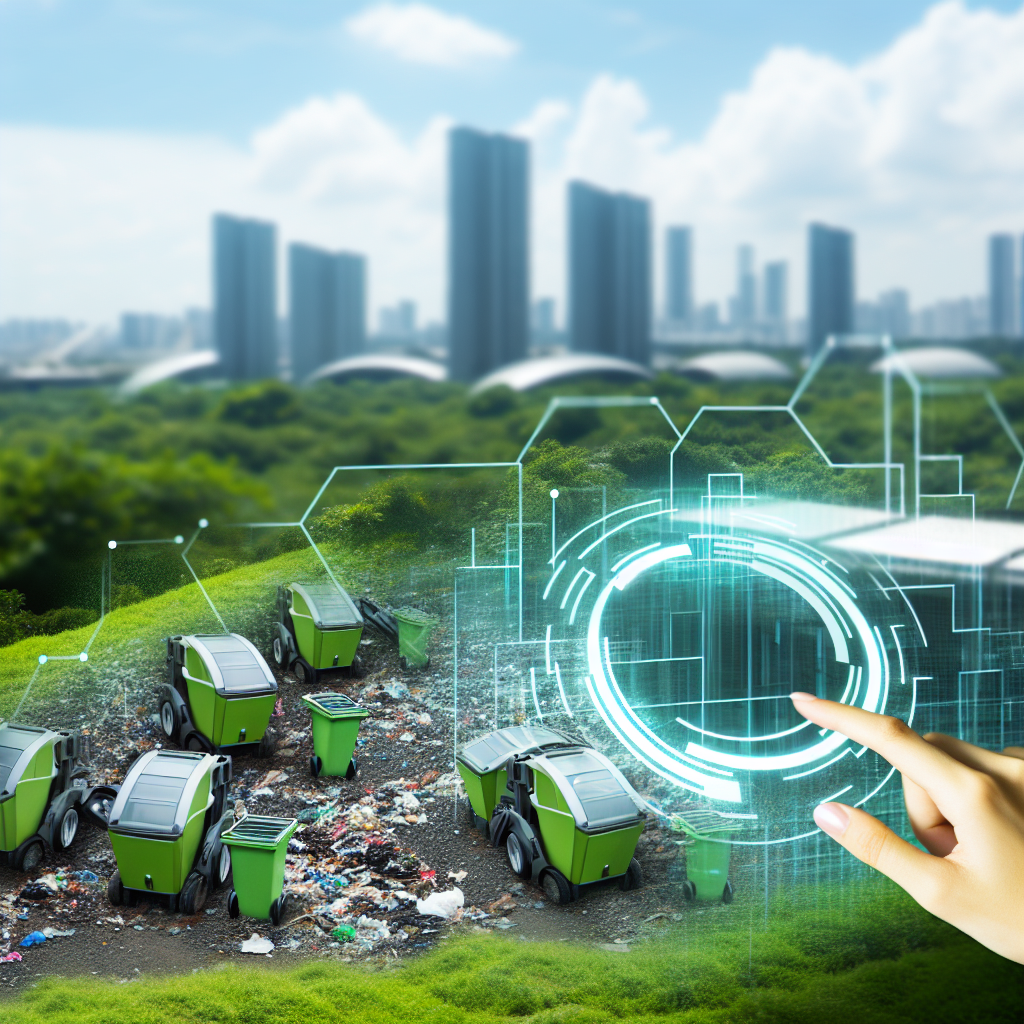Revolutionizing Waste Management: How IoT Waste Solutions Are Transforming Valet Trash Services in 2025
In recent years, the waste management industry has witnessed a significant transformation, driven by the integration of Internet of Things (IoT) technologies. As we look towards 2025, valet trash services are at the forefront of this revolution, leveraging IoT solutions to enhance efficiency, sustainability, and customer satisfaction. The adoption of IoT in waste management is not merely a trend but a necessity, as urban areas continue to expand and the demand for efficient waste disposal systems grows. By incorporating smart technologies, valet trash services are poised to address the challenges of traditional waste management methods, offering innovative solutions that are both environmentally friendly and economically viable.
One of the primary ways IoT is transforming valet trash services is through the use of smart sensors. These sensors, installed in waste bins, provide real-time data on fill levels, enabling service providers to optimize collection routes and schedules. This data-driven approach not only reduces operational costs by minimizing unnecessary pickups but also decreases the carbon footprint associated with waste collection vehicles. Moreover, the ability to monitor waste levels remotely allows for more responsive service, ensuring that bins are emptied before they overflow, thus maintaining cleanliness and hygiene in residential and commercial areas.
In addition to smart sensors, the integration of IoT in valet trash services includes the use of advanced analytics platforms. These platforms analyze data collected from various sources, offering insights into waste generation patterns and helping service providers make informed decisions. For instance, by understanding peak waste generation times, companies can allocate resources more effectively, ensuring that they are adequately prepared to handle increased volumes. Furthermore, predictive analytics can forecast future waste trends, allowing for proactive planning and resource allocation. This level of insight is invaluable in creating a more efficient and sustainable waste management system.
Another significant innovation in valet trash services is the implementation of mobile applications that enhance customer interaction and service delivery. These apps allow residents to schedule pickups, report issues, and receive notifications about service updates. By providing a direct communication channel between service providers and customers, these applications improve transparency and accountability. Additionally, they offer a platform for feedback, enabling companies to continuously refine their services based on customer input. This customer-centric approach not only enhances satisfaction but also fosters a sense of community involvement in waste management efforts.
The environmental benefits of IoT-enabled valet trash services are also noteworthy. By optimizing collection routes and reducing the frequency of pickups, these services contribute to lower greenhouse gas emissions. Moreover, the data collected can be used to promote recycling and waste reduction initiatives, encouraging residents to adopt more sustainable practices. For example, by identifying areas with high recyclable waste, service providers can implement targeted recycling programs, further reducing the environmental impact of waste disposal.
As we move towards 2025, the continued evolution of IoT technologies promises to further revolutionize valet trash services. The integration of artificial intelligence and machine learning could enhance predictive capabilities, while advancements in sensor technology may offer even more precise data collection. Ultimately, the success of these innovations hinges on collaboration between technology providers, waste management companies, and local governments. By working together, these stakeholders can create a more efficient, sustainable, and customer-focused waste management system that meets the needs of modern urban living. In conclusion, the future of valet trash services is bright, with IoT technologies playing a pivotal role in shaping a cleaner and more sustainable world.
Smart Trash and Automated Collection: The Future of Valet Trash Tech and Modern Waste Solutions
As we approach 2025, the landscape of valet trash services is undergoing a significant transformation, driven by technological advancements and innovative solutions. The integration of smart trash systems and automated collection methods is revolutionizing the way waste is managed, offering enhanced efficiency and sustainability. This evolution is not only reshaping the operational dynamics of valet trash services but also setting new standards for modern waste management solutions.
At the forefront of this transformation is the implementation of smart trash technology. These systems utilize sensors and Internet of Things (IoT) connectivity to monitor waste levels in real-time. By providing accurate data on bin capacity and waste types, smart trash systems enable more efficient collection schedules, reducing unnecessary pickups and optimizing route planning. This not only minimizes operational costs but also contributes to a reduction in carbon emissions, aligning with global sustainability goals. Furthermore, the data collected can be analyzed to identify waste generation patterns, allowing for more informed decision-making and strategic planning.
In tandem with smart trash systems, automated collection methods are gaining traction as a pivotal component of modern valet trash services. Automated vehicles equipped with robotic arms and advanced navigation systems are being deployed to streamline the collection process. These vehicles can efficiently maneuver through residential complexes, collecting waste with minimal human intervention. The automation of waste collection not only enhances operational efficiency but also addresses labor shortages, a common challenge faced by the waste management industry. Moreover, the precision and reliability of automated systems ensure consistent service quality, enhancing customer satisfaction.
The integration of these technologies is not without its challenges. The initial investment required for smart trash systems and automated vehicles can be substantial, posing a barrier for smaller service providers. However, the long-term benefits, including cost savings and environmental impact, often outweigh the initial expenditure. Additionally, the transition to technology-driven solutions necessitates a shift in workforce skills. Training programs and upskilling initiatives are essential to equip employees with the knowledge required to operate and maintain these advanced systems.
As we look towards 2025, it is crucial for stakeholders in the valet trash industry to embrace these technological innovations. Collaboration between technology providers, waste management companies, and regulatory bodies will be key to overcoming implementation challenges and ensuring the successful integration of smart trash and automated collection systems. By fostering partnerships and sharing best practices, the industry can collectively advance towards a more sustainable and efficient future.
In conclusion, the advent of smart trash technology and automated collection methods marks a new era for valet trash services. These innovations promise to enhance operational efficiency, reduce environmental impact, and improve service quality. As the industry navigates this technological shift, it is imperative to prioritize investment in these solutions and foster a culture of continuous learning and adaptation. By doing so, valet trash services can not only meet the demands of modern waste management but also contribute to a cleaner, more sustainable world. As we stand on the brink of 2025, the future of valet trash services is undoubtedly bright, driven by technology and innovation.
Innovative Waste Management: Expert Tips on Leveraging Trash Tech for Efficient Valet Trash Services in 2025
As we approach 2025, the landscape of waste management is undergoing a significant transformation, driven by technological advancements and innovative practices. Valet trash services, a niche yet essential component of residential waste management, are no exception to this trend. These services, which involve the doorstep collection of waste from apartment complexes and residential communities, are increasingly leveraging technology to enhance efficiency, sustainability, and customer satisfaction. To remain competitive and effective in this evolving market, it is crucial for service providers to embrace these innovations and implement expert strategies.
One of the most significant technological advancements in valet trash services is the integration of smart waste management systems. These systems utilize Internet of Things (IoT) devices and sensors to monitor waste levels in real-time, allowing service providers to optimize collection schedules and routes. By analyzing data collected from these sensors, companies can predict peak waste generation times and adjust their operations accordingly, reducing unnecessary trips and minimizing fuel consumption. This not only leads to cost savings but also contributes to environmental sustainability by lowering carbon emissions.
In addition to IoT, the use of mobile applications has become increasingly prevalent in valet trash services. These apps provide a platform for seamless communication between service providers and residents, offering features such as service requests, notifications, and feedback mechanisms. By facilitating direct interaction, mobile apps enhance customer engagement and satisfaction, as residents can easily report issues or request additional services. Furthermore, these applications can be integrated with payment systems, streamlining billing processes and ensuring timely transactions.
Artificial intelligence (AI) is another technological frontier that is reshaping valet trash services. AI algorithms can analyze vast amounts of data to identify patterns and trends in waste generation, enabling service providers to make informed decisions about resource allocation and operational strategies. For instance, AI can help determine the optimal number of staff required for specific routes or predict when equipment maintenance is necessary, thereby reducing downtime and improving service reliability.
Moreover, the adoption of electric and hybrid vehicles in valet trash fleets is gaining momentum as companies strive to reduce their environmental footprint. These vehicles not only offer lower operating costs due to reduced fuel consumption but also align with the growing demand for sustainable business practices. As battery technology continues to advance, the range and efficiency of electric vehicles are expected to improve, making them an increasingly viable option for waste collection services.
To fully leverage these technological innovations, it is essential for valet trash service providers to invest in employee training and development. Ensuring that staff are proficient in using new technologies and understand the benefits they offer is crucial for successful implementation. Additionally, fostering a culture of innovation within the organization can encourage employees to contribute ideas and solutions that further enhance service delivery.
In conclusion, the future of valet trash services in 2025 is poised to be shaped by a confluence of technological advancements and innovative practices. By embracing smart waste management systems, mobile applications, AI, and sustainable vehicle options, service providers can enhance operational efficiency, reduce environmental impact, and improve customer satisfaction. As the industry continues to evolve, staying informed about emerging technologies and trends will be key to maintaining a competitive edge and delivering exceptional service in the years to come.
Discover the future of waste management with cutting-edge technology and innovations in valet trash services. Stay ahead in 2025 with expert tips and insights. Learn more now!



